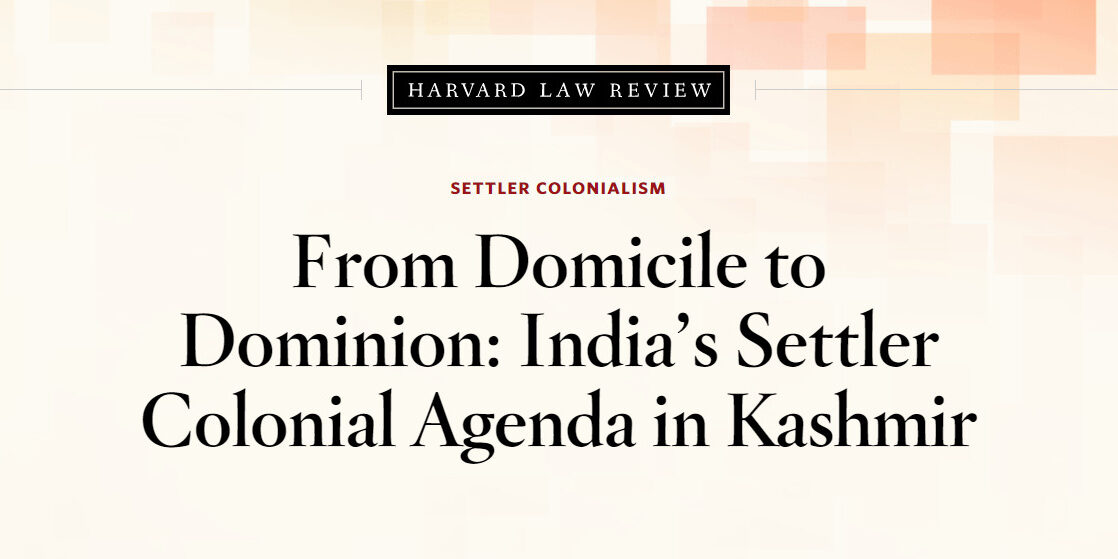Harvard Law Review: From Domicile to Dominion: India’s Settler Colonial Agenda in Kashmir
On August 5, 2019, the Indian government revoked the autonomous status of Jammu and Kashmir by abrogating Articles 370 and 35A of the Indian Constitution. Although many saw Article 370 as largely symbolic, Article 35A of the Constitution had a practical function for preserving Kashmiri identity. Article 35A vested Kashmir’s legislative assembly with the sole authority to define “permanent residents.” Significantly, the local government was able to affix special privileges — such as the ability to purchase land — to permanent residents. The effect was that only Kashmiris could own property in a region that India has long claimed as its own. In revoking Article 35A, the Indian government unearthed a fear that Kashmiris had been wrestling with since Independence: that India would recruit non-Kashmiri settlers to dilute the region’s ethnic and religious makeup.
August 5, then, marked a critical turning point in the Kashmir dispute. Although the colonial lens has been applied to Kashmir in the past, the abrogation suggests that the settler colonial lens may be more fitting. Settler colonialism is premised on the recruitment of a settler class whose goal is not only to occupy indigenous land but also to eliminate the indigenes who stand in their way. Thus, as non-Kashmiris flood the region as new residents, India’s identity as a settler state comes to the fore.
The law often plays a crucial role in facilitating the erasure and elimination of indigenous communities in settler colonial projects. Exploring features of the post-Partition legal regime — especially military impunity, arbitrary detention, and displacement — reveals how the settler colonial mindset animated India’s relationship with Kashmir long before the events of August 5th.
This Note uses settler colonial theory to explain how the August 5 abrogation came about. It begins by laying out a theoretical framework for understanding settler colonialism. Next, it contextualizes and documents the legally momentous events of August 5, 2019, highlighting both the thwarted promises of Kashmiri autonomy and the growing settler colonial desire to control Kashmir and its land. It concludes by analyzing the legal regime that facilitated the full emergence of the settler project today. While August 5 may have been the tipping point for the settler colonial project in Kashmir, it was in no way the start.
Read more / full at — From Domicile to Dominion: India’s Settler Colonial Agenda in Kashmir
Harvard Law Review: From Domicile to Dominion: India’s Settler Colonial Agenda in Kashmir
On August 5, 2019, the Indian government revoked the autonomous status of Jammu and Kashmir by abrogating Articles 370 and 35A of the Indian Constitution. Although many saw Article 370 as largely symbolic, Article 35A of the Constitution had a practical function for preserving Kashmiri identity. Article 35A vested Kashmir’s legislative assembly with the sole authority to define “permanent residents.” Significantly, the local government was able to affix special privileges — such as the ability to purchase land — to permanent residents. The effect was that only Kashmiris could own property in a region that India has long claimed as its own. In revoking Article 35A, the Indian government unearthed a fear that Kashmiris had been wrestling with since Independence: that India would recruit non-Kashmiri settlers to dilute the region’s ethnic and religious makeup.
August 5, then, marked a critical turning point in the Kashmir dispute. Although the colonial lens has been applied to Kashmir in the past, the abrogation suggests that the settler colonial lens may be more fitting. Settler colonialism is premised on the recruitment of a settler class whose goal is not only to occupy indigenous land but also to eliminate the indigenes who stand in their way. Thus, as non-Kashmiris flood the region as new residents, India’s identity as a settler state comes to the fore.
The law often plays a crucial role in facilitating the erasure and elimination of indigenous communities in settler colonial projects. Exploring features of the post-Partition legal regime — especially military impunity, arbitrary detention, and displacement — reveals how the settler colonial mindset animated India’s relationship with Kashmir long before the events of August 5th.
This Note uses settler colonial theory to explain how the August 5 abrogation came about. It begins by laying out a theoretical framework for understanding settler colonialism. Next, it contextualizes and documents the legally momentous events of August 5, 2019, highlighting both the thwarted promises of Kashmiri autonomy and the growing settler colonial desire to control Kashmir and its land. It concludes by analyzing the legal regime that facilitated the full emergence of the settler project today. While August 5 may have been the tipping point for the settler colonial project in Kashmir, it was in no way the start.
Read more / full at — From Domicile to Dominion: India’s Settler Colonial Agenda in Kashmir
- A tribute to the Resilience of Kashmiri Women - March 8, 2024
- Cycle Rally in Islamabad to show solidarity with people of Kashmir. - February 4, 2024
- 5th February, Kashmir Solidarity Day - February 4, 2024









Comment Here